-
PESQUISA01/01/2017
Promoting oral care in the preschool child: effects of a playful learning intervention
Revista Brasileira de Enfermagem. 2017;70(3):519-525
Resumen
PESQUISAPromoting oral care in the preschool child: effects of a playful learning intervention
Revista Brasileira de Enfermagem. 2017;70(3):519-525
DOI 10.1590/0034-7167-2016-0237
Visualizações0Ver maisABSTRACT
Objective:
To compare the number of appropriate behaviors for tooth brushing before and after a playful learning intervention with preschool children.
Method:
A quasi-experimental, quantitative, before and after study design was conducted in an early childhood educational institution, with children between three and five years of age. The intervention consisted of three meetings with educational activities about tooth brushing, whose outcome was evaluated by means of observation of ten behaviors suitable for tooth brushing.
Results:
Forty-four children participated in the study. The mean of adequate behaviors was 4.4 before the intervention, and 8.5 after the intervention. A significant increase in the adoption of appropriate behaviors for tooth brushing (p <0.01) was identified.
Conclusion:
Nurses can enhance oral health promotion actions with preschoolers in preschool institution using playful learning interventions
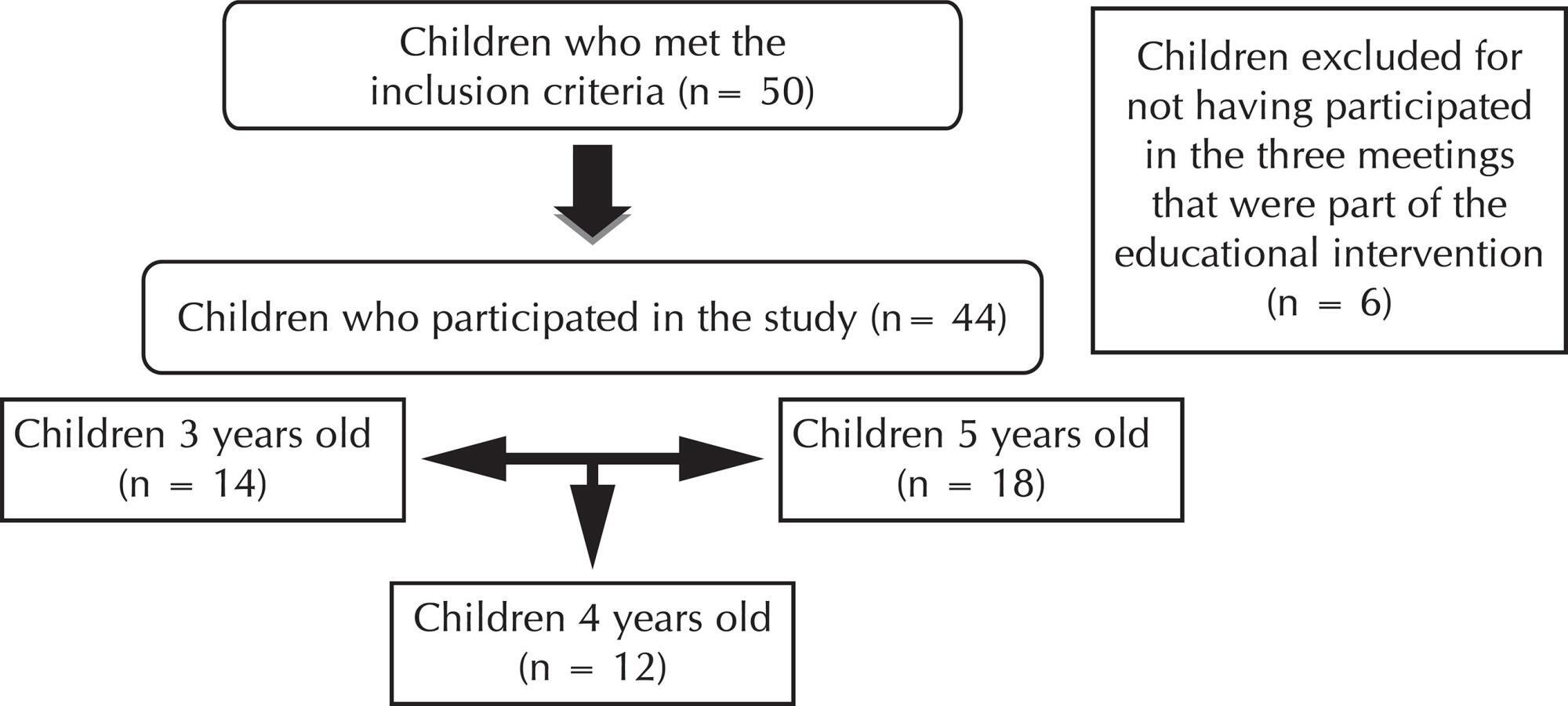
-
PESQUISA01/01/2017
Violence against children and adolescents: the perspective of Primary Health Care
Revista Brasileira de Enfermagem. 2017;70(3):511-518
Resumen
PESQUISAViolence against children and adolescents: the perspective of Primary Health Care
Revista Brasileira de Enfermagem. 2017;70(3):511-518
DOI 10.1590/0034-7167-2016-0471
Visualizações0Ver maisABSTRACT
Objective:
To analyze the care provided by Basic Health Units (BHU) to families involved in domestic intrafamily violence against children and adolescents.
Method:
Qualitative research, based on the Paradigm of Complexity. Data collection was performed with 41 professionals through focus groups and semi-structured interviews.
Results:
The following categories emerged from data analysis: ‘Everything comes here’, which reflects the legitimate place of BHUs for the population and the actions taken to build care for families; and ‘We only do what is really necessary’, which brings the look to violence still based on the positivist and biomedical paradigm.
Final considerations:
The model of understanding and construction of work processes in the BHU is structured in the aforementioned paradigm. Nurses have the possibility to become agents of change, both in professionals’ training and in the care thought and provided to communities.
-
PESQUISA01/01/2017
Integrality of care: challenges for the nurse practice
Revista Brasileira de Enfermagem. 2017;70(3):504-510
Resumen
PESQUISAIntegrality of care: challenges for the nurse practice
Revista Brasileira de Enfermagem. 2017;70(3):504-510
DOI 10.1590/0034-7167-2016-0380
Visualizações0Ver maisABSTRACT
Objective:
to understand the role of the nurse in the collegiate management model of a teaching hospital, in the integrality of care perspective.
Method:
a single case study with multiple units of analysis, with the theoretical proposition «integrality of care is a result of the care offered to the user by multiple professionals, including the nurse». Data were obtained in a functional unit of a teaching hospital through interviews with 13 nurses in a non-participant observation and document analysis.
Results:
from the analytical categories emerged subcategories that allowed understanding that the nurse promotes integrality of care through nursing management, team work and integration of services.
Final considerations:
the theoretical proposition was confirmed and it was verified that the nursing management focus on attending to health care needs and is a strategy to provide integrality of care.
-
PESQUISA01/01/2017
Low completion rate of hepatitis B vaccination in female sex workers
Revista Brasileira de Enfermagem. 2017;70(3):489-494
Resumen
PESQUISALow completion rate of hepatitis B vaccination in female sex workers
Revista Brasileira de Enfermagem. 2017;70(3):489-494
DOI 10.1590/0034-7167-2016-0567
Visualizações0Ver maisABSTRACT
Objective:
to assess predictive factors for noncompletion of the hepatitis B vaccination schedule in female sex workers in the city of Teresina, Northeastern Brazil.
Method:
402 women were interviewed and, for those who did not wish to visit specialized sites, or did not know their hepatitis B vaccination status, the vaccine was offered at their workplaces. Bi- and multivariate analyses were performed to identify potential predictors for noncompletion of the vaccination schedule.
Results:
of the 284 women eligible for vaccination, 258 (90.8%) received the second dose, 157/258 (60.8%) and 68/258 (26.3%) received the second and third doses, respectively. Working at clubs and consuming illicit drugs were predictors for noncompletion of the vaccination schedule.
Conclusion:
the high acceptability of the vaccine’s first dose, associated with low completion rates of the vaccination schedule in sex workers, shows the need for more persuasive strategies that go beyond offering the vaccine at their workplaces.
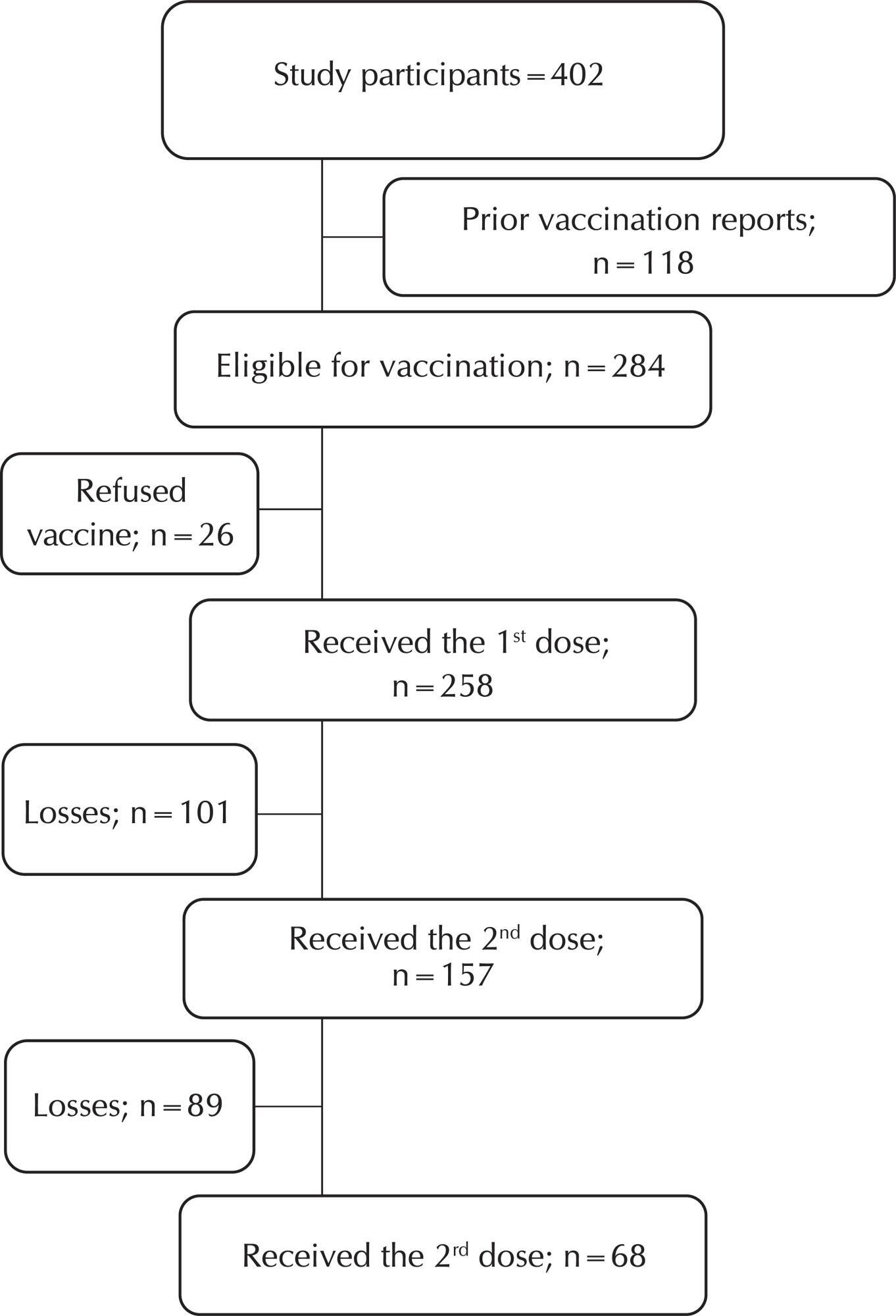
-
PESQUISA01/01/2017
Cost of nursing most frequent procedures performed on severely burned patients
Revista Brasileira de Enfermagem. 2017;70(3):481-488
Resumen
PESQUISACost of nursing most frequent procedures performed on severely burned patients
Revista Brasileira de Enfermagem. 2017;70(3):481-488
DOI 10.1590/0034-7167-2015-0034
Visualizações0Ver maisABSTRACT
Objective:
to identify the mean direct cost (MDC) of the most frequent procedures performed by nursing professionals on severely burned patients in an Intensive Care Unit.
Method:
exploratory-descriptive quantitative single-case study. The MDC was calculated by multiplying time (timed) spent by nursing professionals in the performance of the procedures by the unit cost of direct labor, and adding the costs of material and medicine/solutions.
Results:
a MDC of US$ 0.65 (SD=0.36) was obtained for «vital signs monitoring»; US$ 10.00 (SD=24.23) for «intravenous drug administration»; US$ 5.90 (SD=2.75) for «measurement of diuresis»; US$ 0.93 (SD=0.42) for «capillary blood glucose monitoring»; and US$ 99.75 (SD=129.55) for «bandaging».
Conclusion:
the knowledge developed can support managerial decision-making, contribute to the efficiency distribution of the resources involved and, when possible, provide cost-containment or cost-minimization strategies without impairing the quality of nursing care.
-
PESQUISA01/01/2017
Nursing Activities Score and Acute Kidney Injury
Revista Brasileira de Enfermagem. 2017;70(3):475-480
Resumen
PESQUISANursing Activities Score and Acute Kidney Injury
Revista Brasileira de Enfermagem. 2017;70(3):475-480
DOI 10.1590/0034-7167-2016-0266
Visualizações0Ver maisABSTRACT
Objective:
to evaluate the nursing workload in intensive care patients with acute kidney injury (AKI).
Method:
A quantitative study, conducted in an intensive care unit, from April to August of 2015. The Nursing Activities Score (NAS) and Kidney Disease Improving Global Outcomes (KDIGO) were used to measure nursing workload and to classify the stage of AKI, respectively.
Results:
A total of 190 patients were included. Patients who developed AKI (44.2%) had higher NAS when compared to those without AKI (43.7% vs 40.7%), p <0.001. Patients with stage 1, 2 and 3 AKI showed higher NAS than those without AKI. A relationship was identified between stage 2 and 3 with those without AKI (p = 0.002 and p <0.001).
Conclusion:
The NAS was associated with the presence of AKI, the score increased with the progression of the stages, and it was associated with AKI, stage 2 and 3.
-
PESQUISA01/01/2017
Nursing appointment and cardiometabolic control of diabetics: a randomized clinical trial
Revista Brasileira de Enfermagem. 2017;70(3):468-474
Resumen
PESQUISANursing appointment and cardiometabolic control of diabetics: a randomized clinical trial
Revista Brasileira de Enfermagem. 2017;70(3):468-474
DOI 10.1590/0034-7167-2016-0352
Visualizações0Ver maisABSTRACT
Objective:
to verify the effect of nursing appointment on cardiometabolic profile of people with Diabetes Mellitus type 2.
Method:
randomized controlled trial, developed with 134 individuals chosen for two groups: intervention and control. The intervention consisted of three nursing appointments alternated bimonthly, with two phone calls, over five months. The control group received usual care offered by the Health Unit. Data were collected through semi-structured interviews before and after the intervention, in addition to conducting laboratory tests.
Results:
after the intervention, a significant difference was shown in the amount of glycated hemoglobin (p = 0.006) and in the systolic blood pressure (p = 0.031), which were higher in the control group.
Conclusion:
besides being low-cost and easy to develop on the monitoring routine of people with diabetes, the intervention performed influenced positively the biochemical profile.
-
PESQUISA01/01/2017
Terms of the specialized nursing language for the care of ostomates
Revista Brasileira de Enfermagem. 2017;70(3):461-467
Resumen
PESQUISATerms of the specialized nursing language for the care of ostomates
Revista Brasileira de Enfermagem. 2017;70(3):461-467
DOI 10.1590/0034-7167-2015-0058
Visualizações0Ver maisABSTRACT
Objectives:
to identify terms of the specialized nursing language for the care of ostomates from the literature of the area, and to map the identified terms with terms of the International Classification for Nursing Practice (ICNP®).
Method:
descriptive study of quantitative approach guided by the guidelines for the elaboration of terminology subsets of the ICNP®. The terms were collected in 49 scientific articles, extracted using a computational tool, selected according to the relevance for the theme, and normalized and mapped with the ICNP®.
Results:
20,668 terms were extracted. The standardization process resulted in 425 relevant terms (151 were constant in ICNP® and 274 were not contained in ICNP®), of which 154 were similar, 19 were more comprehensive, 50 were more restricted, and 51 were not in concordance.
Conclusion:
the use of standardized language can minimize the ambiguities and redundancies identified in the mapping. The existence of terms not in concordance with the ICNP® reinforces the need for constant updating of this classification.
-
ARTÍCULO ORIGINAL08/07/2020
Nurses’ practice in quilombola communities: an interface between cultural and political competence
Revista Brasileira de Enfermagem. 2020;73(5):e20190433
Resumen
ARTÍCULO ORIGINALNurses’ practice in quilombola communities: an interface between cultural and political competence
Revista Brasileira de Enfermagem. 2020;73(5):e20190433
DOI 10.1590/0034-7167-2019-0433
Visualizações1Ver maisABSTRACT
Objectives:
to understand Family Health Strategy nurses’ practices in the context of quilombola communities with an interface for cultural and political competences.
Methods:
a single integrated, qualitative case study carried out on seven Family Health Strategies located in the Metropolitan Region of Belo Horizonte, state of Minas Gerais. Seven nurses and 59 quilombolas participated. Data were collected through individual interviews with nurses, collective interviews with quilombolas and observation. For analysis, the thematic content analysis was adopted.
Results:
the results revealed structural and territorial problems, which are configured as barriers for professional-user encounter as well as for professional practice performance.
Final Considerations:
it is necessary that Family Health Strategy nurses, based on political and cultural competences, create strategies that minimize the difficulties found in the implementation of health actions directed to quilombolas. Such strategies anchored in inclusive public policies.
-
ARTÍCULO ORIGINAL08/07/2020
No to distance education! Production of meaning of discourses of nursing representative entities
Revista Brasileira de Enfermagem. 2020;73(5):e20190465
Resumen
ARTÍCULO ORIGINALNo to distance education! Production of meaning of discourses of nursing representative entities
Revista Brasileira de Enfermagem. 2020;73(5):e20190465
DOI 10.1590/0034-7167-2019-0465
Visualizações0Ver maisABSTRACT
Objectives:
to analyze the processes of production of meanings, based on the positions of Brazilian nursing representative entities, on distance education, considering the implications for nursing as a discipline, profession and work.
Methods:
this documentary research was carried out in sources from the Federal Nursing Council and Associação Brasileira de Enfermagem, from 2015 to 2018. Data were examined from discourse analysis, using paraphrase and polysemy as analytical devices.
Results:
they were organized based on the effects of meanings produced and affiliated to two analytical categories: “Forms of mobilization and operating entities” and “Basis and justifications for the positions”.
Final Considerations:
the discourses signal concern about the future training of new professionals. Resistance, participation, visibility, broad and emphatic debate on the topic are shown as strategies for coping and defending a training process less captured by neoliberal logic, and more relational and committed to the quality of health care.
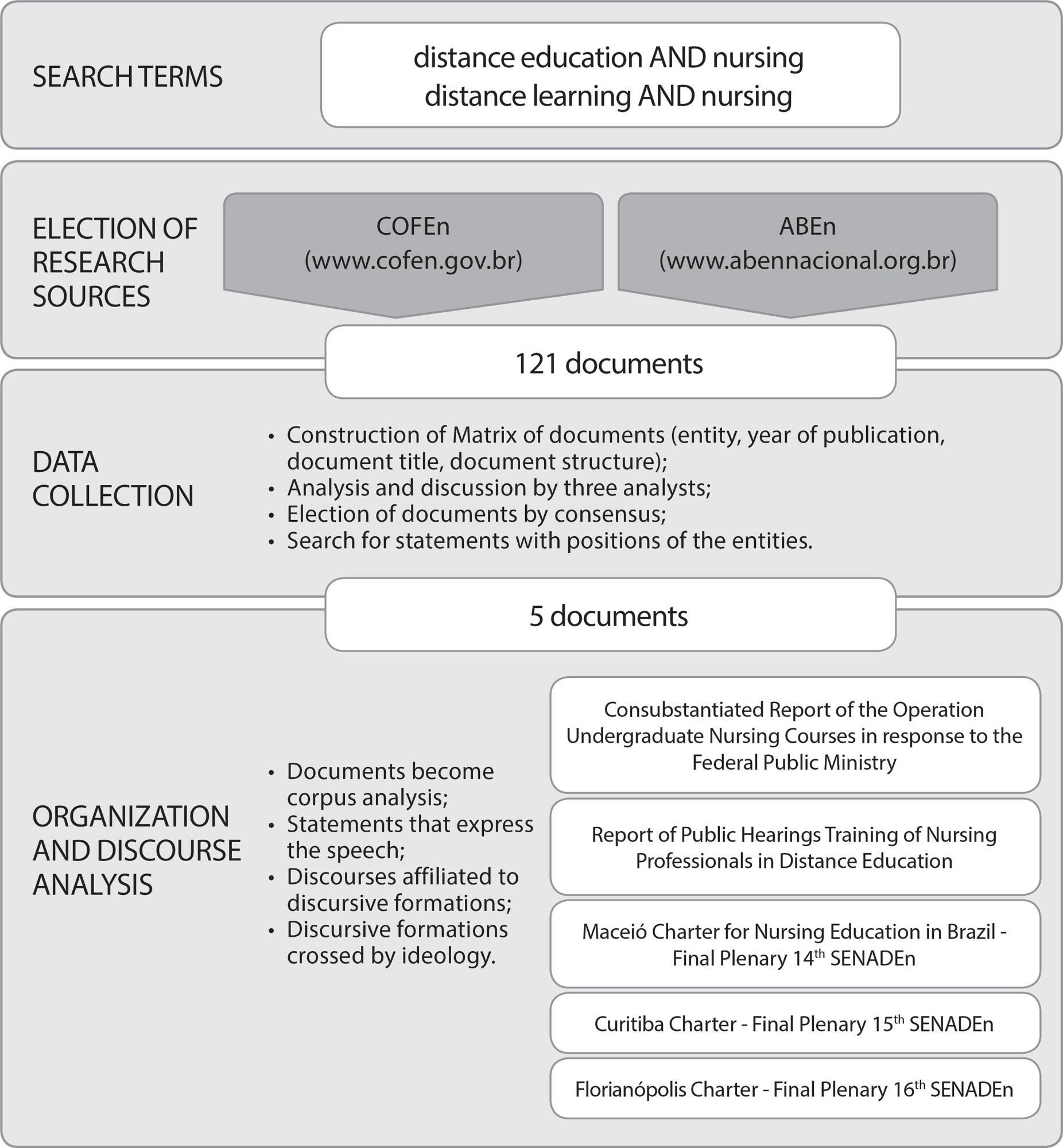
-
ARTÍCULO ORIGINAL13/07/2020
Culture of patient safety in hospital units of gynecology and obstetrics: a cross-sectional study
Revista Brasileira de Enfermagem. 2020;73(5):e20190576
Resumen
ARTÍCULO ORIGINALCulture of patient safety in hospital units of gynecology and obstetrics: a cross-sectional study
Revista Brasileira de Enfermagem. 2020;73(5):e20190576
DOI 10.1590/0034-7167-2019-0576
Visualizações0Ver maisABSTRACT
Objectives:
to assess the patient safety culture of the health team working in three maternity hospitals.
Methods:
observational, cross-sectional, comparative study. 301 professionals participated in the study. The Hospital Survey on Patient Safety Culture questionnaire validated in Brazil was used. For data analysis, it was considered a strong area in the patient safety culture when positive responses reached over 75%; and areas that need improvement when positive responses have reached less than 50%. To compare the results, standard deviation and thumb rule were used.
Results:
of the 12 dimensions of patient safety culture, none obtained a score above 75%, with nine dimensions scoring between 19% and 43% and three dimensions between 55% and 57%.
Conclusions:
no strong dimensions for safety culture were identified in the three maternity hospitals. It is believed that these results may contribute to the development of policies that promote a culture of safety in institutions.
-
ARTÍCULO DE REVISIÓN13/07/2020
The quality of life of family health professionals: a systematic review and meta-synthesis
Revista Brasileira de Enfermagem. 2020;73(5):e20190645
Resumen
ARTÍCULO DE REVISIÓNThe quality of life of family health professionals: a systematic review and meta-synthesis
Revista Brasileira de Enfermagem. 2020;73(5):e20190645
DOI 10.1590/0034-7167-2019-0645
Visualizações1Ver maisABSTRACT
Objectives:
to perform a systematic review and meta-synthesis of qualitative studies about the work-related quality of life of Family Health Strategy professionals.
Methods:
this systematic review was developed to answer the following PVO question: “Which factors (variables) are associated with the work-related quality of life (outcome) of Family Health Strategy professionals (population)?” The PubMed, Scopus, Embase, SciELO, Web of Science, LILACS, Science Direct, OpenThesis, OpenGrey, and OATD databases were selected. The meta-synthesis analyzed the main codes and secondary codes of all included studies.
Results:
the database search resulted in 1,744 reports; six were considered eligible for the meta-synthesis. Four factors were considered for the quality of work life: working conditions; work processes; interpersonal relationships; and personal aspects.
Conclusions:
although this study confirms the adequacy of aspects commonly related to the quality of work life, other factors are important in the case of FHS professionals, especially work context.
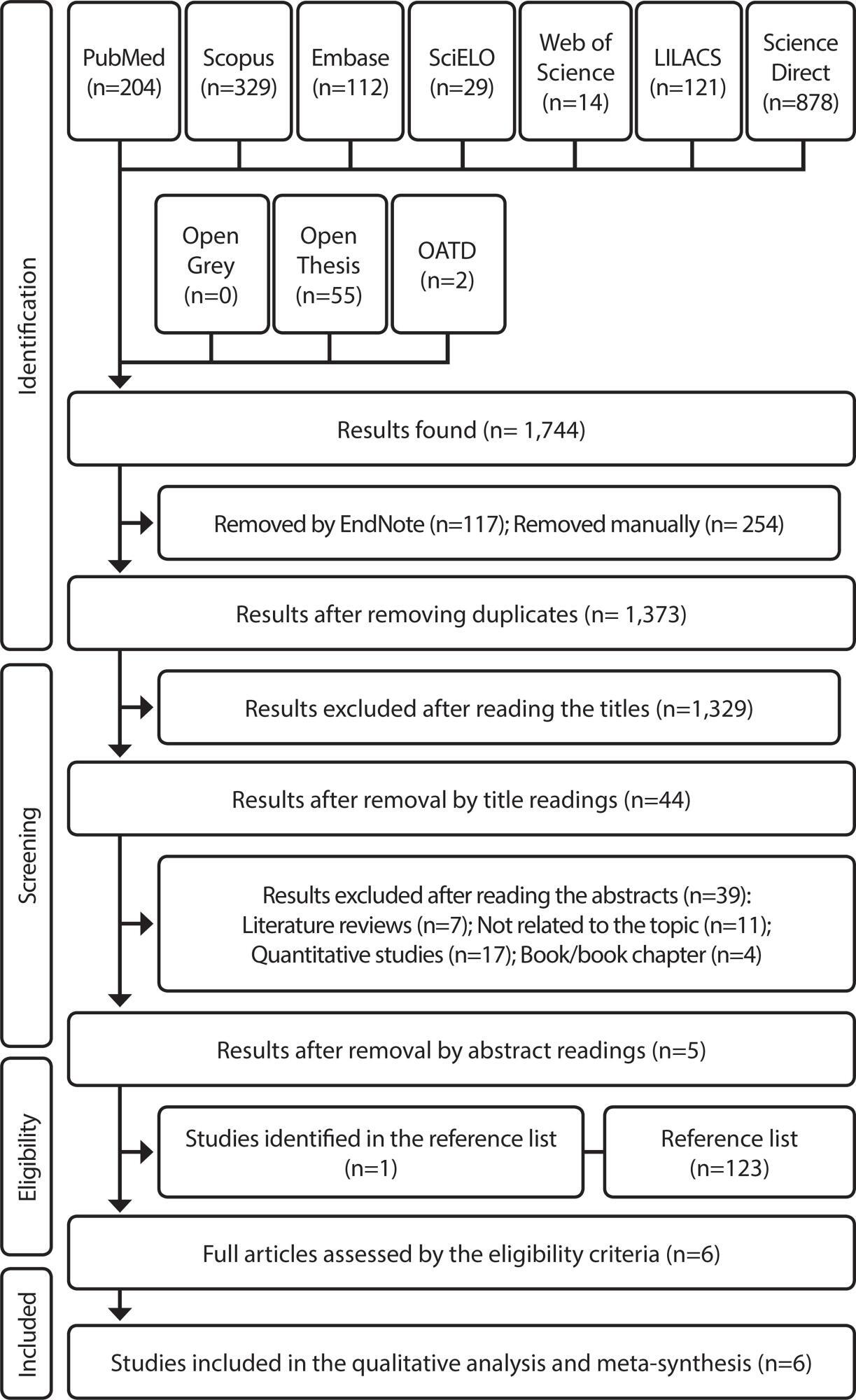
-
CARTA AL EDITOR01/07/2020
Letter to the Editor: doubts and considerations about Coronary Syndrome
Revista Brasileira de Enfermagem. 2020;73(5):e2020730502c
Resumen
CARTA AL EDITORLetter to the Editor: doubts and considerations about Coronary Syndrome
Revista Brasileira de Enfermagem. 2020;73(5):e2020730502c
DOI 10.1590/0034-7167.2020730502c
Visualizações0Dear Editor,We wrote this letter referring to the article “Impact of anxiety and depression on morbidity and mortality of patients with coronary syndrome”() to make some comments, in order to clarify doubts that we were missing from answering. We have already made it clear that our intention is not to question the work of the […]Ver mais -
ARTÍCULO ORIGINAL10/08/2020
Workers’ Health in Brazil: Accidents recorded by Social Security from 2008 to 2014
Revista Brasileira de Enfermagem. 2020;73(6):e20180892
Resumen
ARTÍCULO ORIGINALWorkers’ Health in Brazil: Accidents recorded by Social Security from 2008 to 2014
Revista Brasileira de Enfermagem. 2020;73(6):e20180892
DOI 10.1590/0034-7167-2018-0892
Visualizações0Ver maisABSTRACT
Objectives:
to analyze the incidence of occupational accidents in Brazil, recorded by Social Security according to the geographic regions, age group, gender and their prevalence according to the causes and branch of economic activity.
Methods:
ecological descriptive study with time series analysis from 2008 to 2014. Data on the beginning and end of the historical series were compared in each ecological unit studied.
Results:
the South and Southeast regions, male, between 20 and 49 years of age presented the highest falls in incidence. 70.87% of the causes occurred in group XIX of ICD-10. The economic activity with the highest prevalence of accidents was the manufacturing industry.
Conclusions:
accidents at work have decreased in Brazil, however, the incidence is still high. Advances need to be made in the recording of accidents and in the prevention and surveillance of workers’ health.
-
ARTÍCULO ORIGINAL10/08/2020
Neonatal near miss in the intensive care unit
Revista Brasileira de Enfermagem. 2020;73(6):e20180931
Resumen
ARTÍCULO ORIGINALNeonatal near miss in the intensive care unit
Revista Brasileira de Enfermagem. 2020;73(6):e20180931
DOI 10.1590/0034-7167-2018-0931
Visualizações0Ver maisABSTRACT
Objective:
To analyze near miss cases among newborns hospitalized in the Intensive Care Unit.
Methods:
An observational, cross-sectional, retrospective study using the STROBE guideline. Data were collected from 1,101 records of live births (newborns). Statistical analysis used the Epi-Info program 3.3.2 and Chi-square and Fisher’s exact tests.
Results:
A total of 162 newborns were hospitalized, of which 63 had at least one criterion of near miss. The variables that remained associated with neonatal near miss were weight <1.750 g, gestational age <33 weeks and Apgar at 5 minutes <7, pragmatic criteria to identify cases of neonatal near miss morbidity.
Conclusion:
Prematurity and low birth weight were the factors that contributed most to the near miss outcome among newborns hospitalized in intensive care, a rate two and a half times higher than the number of deaths, according to scientific evidence.

-
10/08/2020
Care for the critical patient undergoing point-of-care testing: integrative review
Revista Brasileira de Enfermagem. 2020;73(6):e20180948
Resumen
Care for the critical patient undergoing point-of-care testing: integrative review
Revista Brasileira de Enfermagem. 2020;73(6):e20180948
DOI 10.1590/0034-7167-2018-0948
Visualizações0Ver maisABSTRACT
Objective:
to identify, based on the evidence, point-of-care testing in bedbound in critically ill patients.
Method:
integrative review, carried out through search in Pubmed, Virtual Health Library, Joanna Briggs Institute, The British Institute of Radiology, Brazilian Radiology, and Google Scholar databases. We used the PICO research strategy and selected articles published from 2013 onwards, which presented information about point-of-care testing.
Results:
the different interventions found in the analysis of the 23 selected articles allowed the thematic grouping of care related to safety in communication, patient identification, care with devices, and the prevention and control of infection, which can be used in point-of-care testing.
Final considerations:
The care described in the evidence provided support for validating a safe care protocol for critically ill patients undergoing imaging studies in bed.
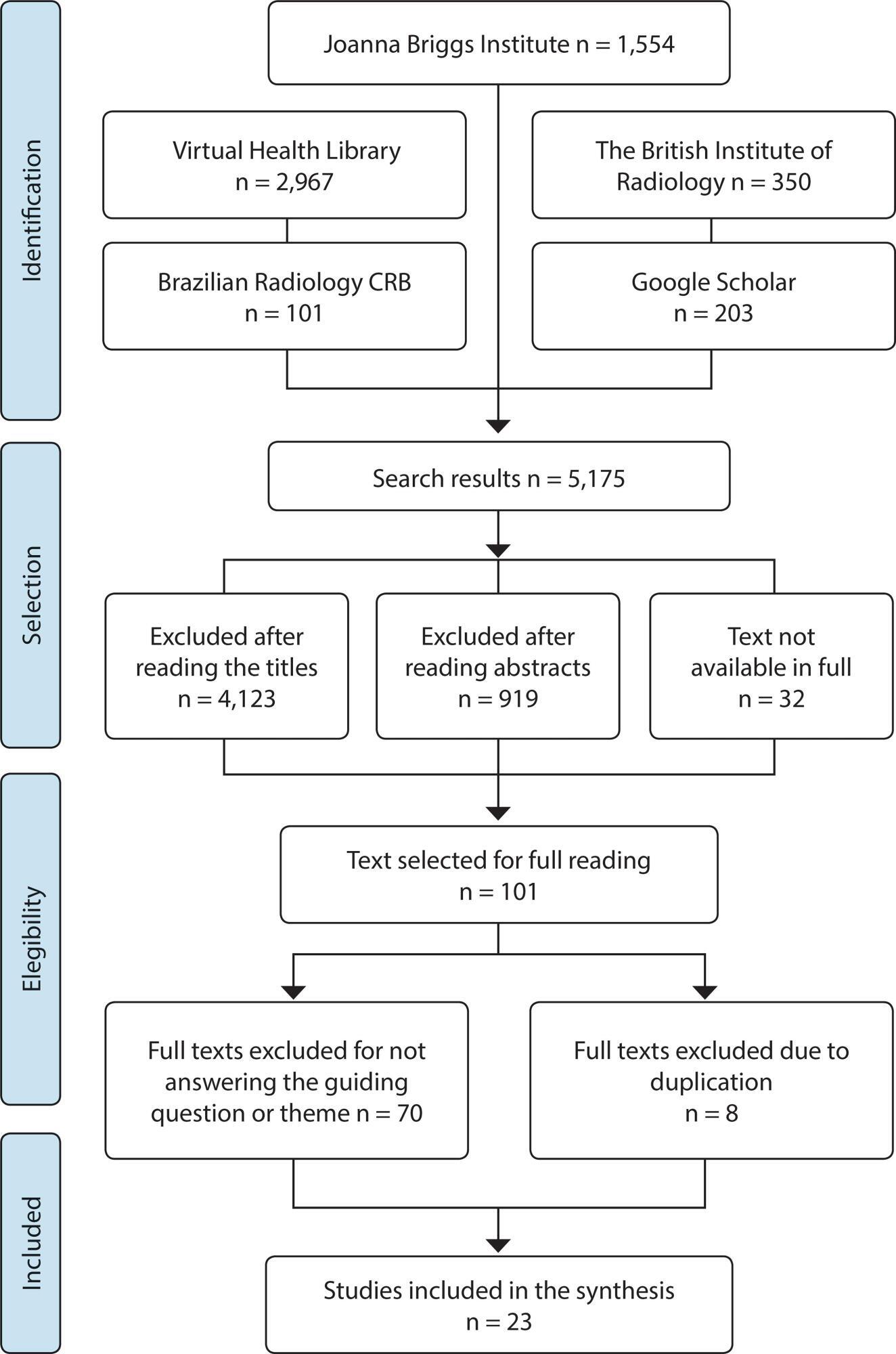
-
ARTÍCULO ORIGINAL08/06/2020
Usabilidade de um aplicativo móvel sobre o autocuidado com o pé diabético
Revista Brasileira de Enfermagem. 2020;73(4):e20180862
Resumen
ARTÍCULO ORIGINALUsabilidade de um aplicativo móvel sobre o autocuidado com o pé diabético
Revista Brasileira de Enfermagem. 2020;73(4):e20180862
DOI 10.1590/0034-7167-2018-0862
Visualizações0Ver maisRESUMO
Objetivos:
avaliar a usabilidade pelo usuário final de um protótipo de aplicativo para o autocuidado com o pé diabético.
Métodos:
estudo descritivo, de avaliação heurística da usabilidade de um aplicativo híbrido. Participaram 15 usuários de um serviço ambulatorial de atenção à pessoa com diabetes de uma capital do Nordeste brasileiro durante o mês de abril de 2018. Foi aplicado o instrumento de mensuração de usabilidade chamado Smartphone Usability questionnaiRE.
Resultados:
obteve-se como menor escore 77 e maior 112, com média de usabilidade geral de 96,1 pontos. A usabilidade foi enquadrada nos dois últimos níveis, 70 e 80. Os usuários passam a concordar fortemente (nível 70) e totalmente (nível 80) com os itens avaliados, o que representa boa usabilidade do protótipo de aplicativo.
Conclus
ões: o produto final desenvolvido tem foco nas necessidades e exigências do usuário, o que pode garantir a usabilidade, com base na tríade eficácia, eficiência e satisfação.
-
ARTÍCULO ORIGINAL18/10/2022
Percurso metodológico para alcance do grau de saturação na pesquisa qualitativa: teoria fundamentada
Revista Brasileira de Enfermagem. 2022;75(2):e20201379
Resumen
ARTÍCULO ORIGINALPercurso metodológico para alcance do grau de saturação na pesquisa qualitativa: teoria fundamentada
Revista Brasileira de Enfermagem. 2022;75(2):e20201379
DOI 10.1590/0034-7167-2020-1379
Visualizações0Ver maisRESUMO
Objetivos:
alcançar o grau de saturação em estudo que aplicou a teoria fundamentada.
Métodos:
pesquisa qualitativa, realizada em quatro Unidades Saúde da Família, entre junho de 2018 e maio de 2019. Os dados das entrevistas com 30 profissionais de saúde e observação não participante foram codificados nas etapas: aberta, axial e integração.
Resultados:
o grau de saturação foi alcançado por dois modelos conceituais – saturação teórica e temática indutiva. Foram considerados para a saturação teórica: o desenvolvimento dos códigos conceituais e a observação, na coleta e análise dos dados, quando geravam novas categorias/subcategorias ou apenas indicavam instâncias crescentes. Para a saturação temática indutiva, destacou-se a utilização de novos códigos baseados em cada entrevista.
Considerações Finais:
a esquematização visual para a quantidade de códigos, abrangência teórica dos conceitos e delimitação dos grupos amostrais orientou a identificação do grau de saturação para o desenvolvimento do corpo conceitual que sustentou a teoria substantiva.
-
ARTÍCULO ORIGINAL05/12/2019
Elderly caregivers of the elderly: frailty, loneliness and depressive symptoms
Revista Brasileira de Enfermagem. 2019;72:88-96
Resumen
ARTÍCULO ORIGINALElderly caregivers of the elderly: frailty, loneliness and depressive symptoms
Revista Brasileira de Enfermagem. 2019;72:88-96
DOI 10.1590/0034-7167-2018-0137
Visualizações0Ver maisABSTRACT
Objective:
to investigate the association between frailty, loneliness and depressive symptoms of elderly caregivers.
Method:
a cross – sectional study carried out with 341 elderly caregivers enrolled in Family Health Units of a city in the countryside of São Paulo State. The interviews were domiciliary and included questionnaire for characterization of the caregiver, Fried’s frailty phenotype, family APGAR (family functionality), Geriatric Depression Scale (depressive symptoms) and item 3 of the Herth Hope Scale (loneliness). Logistic regression was used to analyze the association between depressive symptoms and solitude (independent variables), and frailty and pre-frailty (dependent variables).
Results:
there was an association between frailty, loneliness and depressive symptoms. Elderly caregivers had increased odds of 158% presenting pre-frailty, and 360% of frailty. Elderly caregivers with depressive symptoms had an increased chance of 242% of presenting fragility.
Conclusion:
elderly and lonely caregivers with depressive symptoms are more likely to be frail and pre-frail.
-
REFLEXIÓN03/05/2021
A teoria de Florence Nightingale e suas contribuições para o pensamento crítico holístico na enfermagem
Revista Brasileira de Enfermagem. 2021;74(2):e20200139
Resumen
REFLEXIÓNA teoria de Florence Nightingale e suas contribuições para o pensamento crítico holístico na enfermagem
Revista Brasileira de Enfermagem. 2021;74(2):e20200139
DOI 10.1590/0034-7167-2020-0139
Visualizações0RESUMO
Objetivo:
refletir sobre o legado de Florence Nightingale e descrever suas contribuições para o pensamento crítico holístico na enfermagem.
Métodos:
trata-se de uma reflexão teórica, para a qual serviram de base produções científicas sobre a teoria ambientalista de Florence Nightingale, publicadas em periódicos nacionais e internacionais.
Resultados:
a filosofia e os ensinamentos de Florence Nightingale enfatizam que a enfermeira deve usar o cérebro, o coração e as mãos na criação de ambientes de cura, para cuidar do corpo do paciente, de sua mente e de seu espírito. A enfermagem, desde a época de Nightingale, vem construindo o paradigma holístico, em todas as escolas de pensamento, com vistas a uma abordagem humanística do ser humano em sua indivisível relação com o ambiente.
Considerações finais:
as contribuições de Florence ao pensamento crítico holístico na enfermagem são evidentes, constituindo o diferencial do enfermeiro na prática clínica.
Palavras-chave: Cuidados de EnfermagemEnfermagemHistória da EnfermagemPensamento CríticoTeoria de EnfermagemVer mais -
19/08/2019
Clinical simulation in nursing education in intensive therapy: an integrative review
Revista Brasileira de Enfermagem. 2019;72(4):1061-1070
Resumen
Clinical simulation in nursing education in intensive therapy: an integrative review
Revista Brasileira de Enfermagem. 2019;72(4):1061-1070
DOI 10.1590/0034-7167-2018-0217
Visualizações0Ver maisABSTRACT
Objective:
to analyze the publications on clinical simulation practices for education in Nursing in Intensive Care.
Method:
an integrative review carried out through LILACS, PubMed, Cochrane Library, CINAHL and SciELO databases, of articles published from 2008 to 2017.
Results:
29 articles were selected, of which 76% discuss the use of simulation in continuing education of nursing professionals, while the others describe their use for student education. There is a higher prevalence of studies with a level of evidence 6 (17), with 28 international publications. There was an increase in scientific production, with 16 articles published in the last three years.
Conclusion:
variables after simulation use, such as confidence, communication skills, efficiency in the identification of clinical worsening of patients, development of technical skills, teamwork and clinical decision-making, presented a significant improvement, demonstrating that this tool is effective in qualifying care for critical patients.
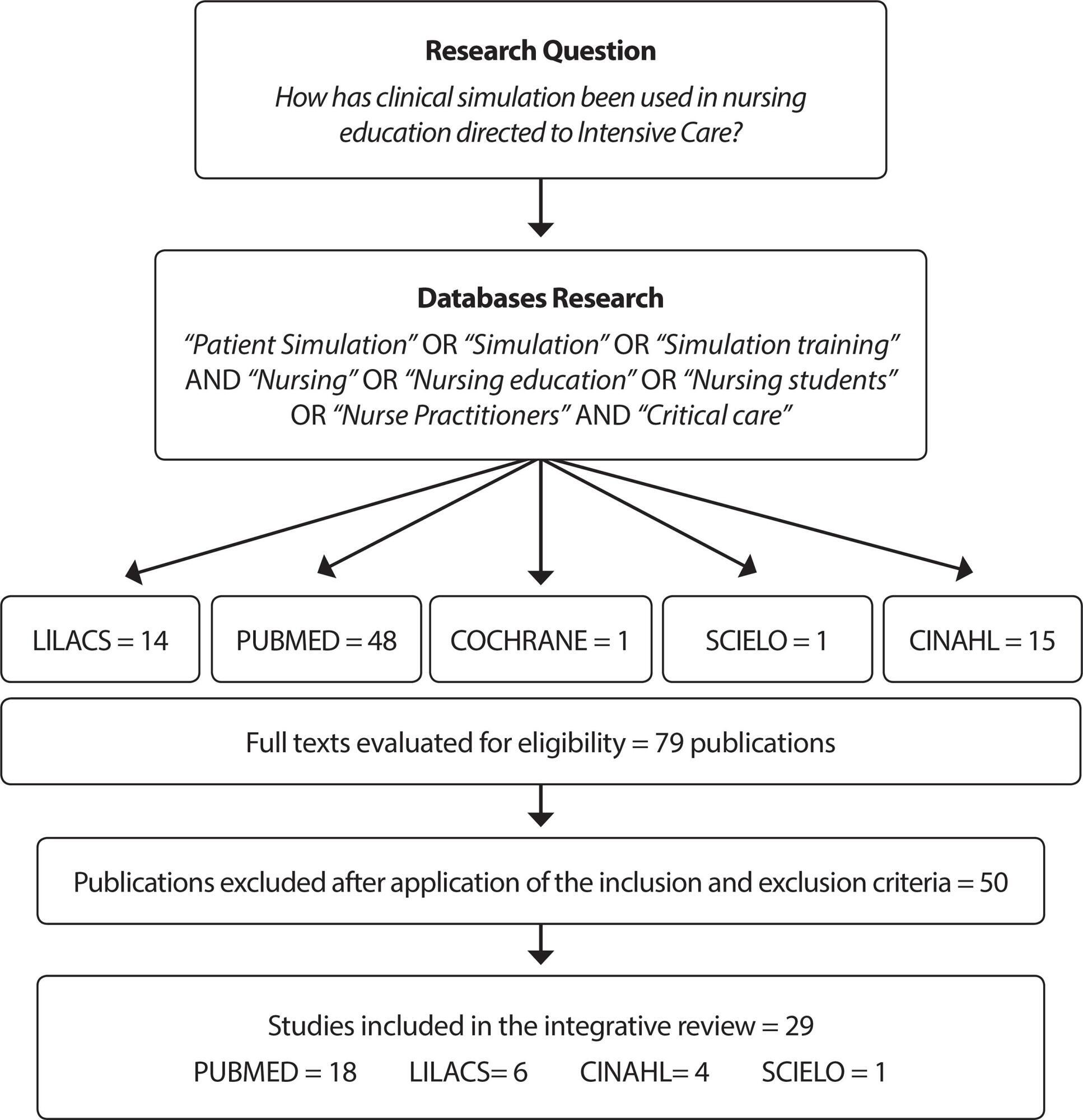
-
ARTÍCULO DE REVISIÓN26/06/2023
Barriers to Pre-Exposure Prophylaxis (PrEP) use for HIV: an integrative review
Revista Brasileira de Enfermagem. 2023;76(3):e20210963
Resumen
ARTÍCULO DE REVISIÓNBarriers to Pre-Exposure Prophylaxis (PrEP) use for HIV: an integrative review
Revista Brasileira de Enfermagem. 2023;76(3):e20210963
DOI 10.1590/0034-7167-2021-0963
Visualizações0Ver maisABSTRACT
Objectives:
to identify and synthesize scientific evidence on the barriers and difficulties for Pre-exposure Prophylaxis (PrEP) use and compliance for HIV.
Methods:
an integrative literature review, using the MEDLINE/PubMed, Cumulative Index to Nursing and Allied Health Literature (CINAHL), Academic Search Premier and Scopus (Elsevier) databases.
Results:
all (100%) the articles included identified that PrEP users experience some type of structural barrier related to health services such as long distance from the units, suboptimal logistics for taking pills and professional resistance to prescribing PrEP. Furthermore, 63.21% identified social barriers, such as stigma about sexuality and HIV, in addition to individual barriers such as alcohol use, adverse effects, and concerns about long-term toxicity.
Conclusions:
the barriers to PrEP use are multifactorial. Effective interventions are needed to support PrEP users in accessing, complying with, and retaining health services.
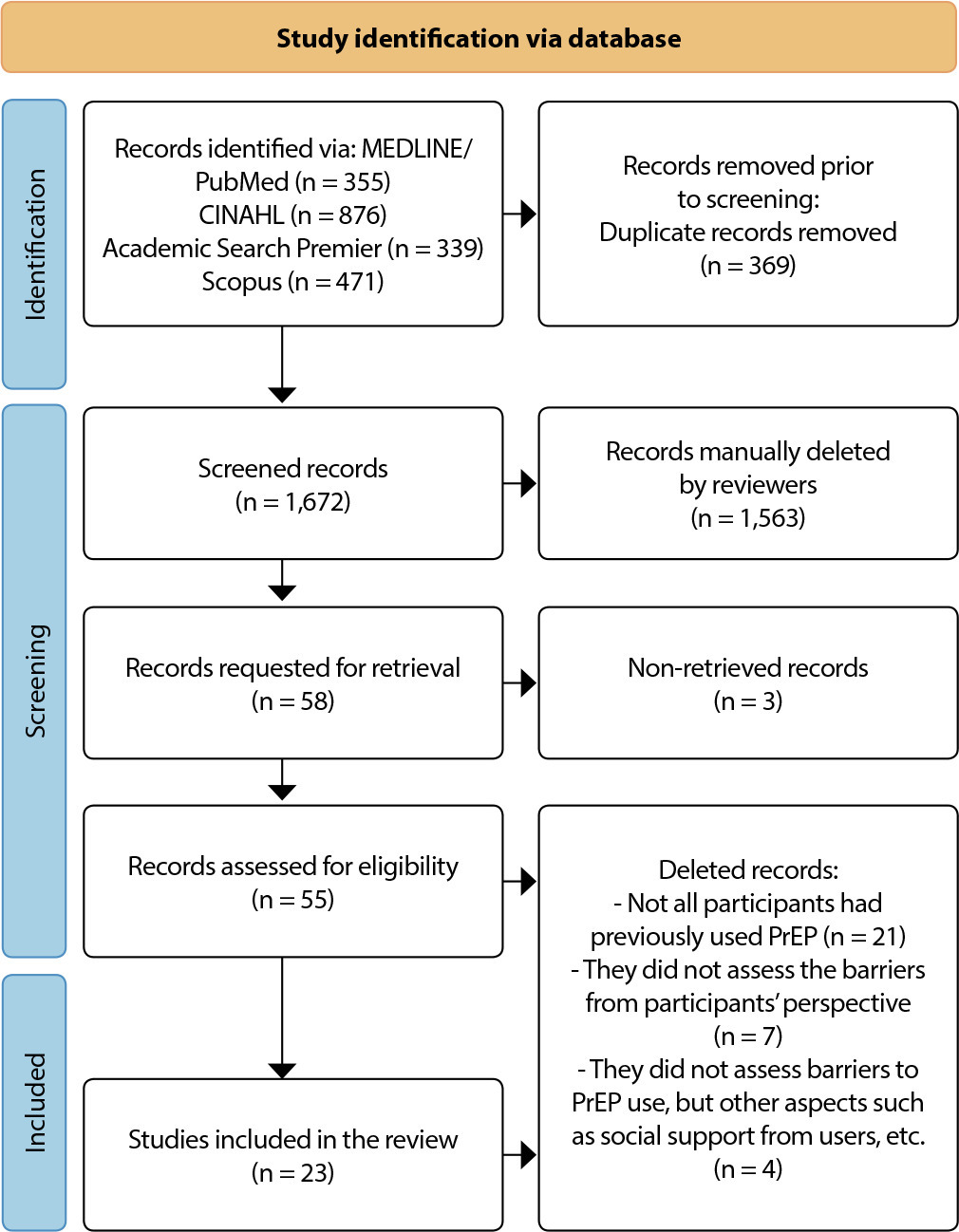
-
ARTÍCULO ORIGINAL21/10/2019
Coping religioso/espiritual e a angústia espiritual em pessoas com câncer
Revista Brasileira de Enfermagem. 2019;72(6):1534-1540
Resumen
ARTÍCULO ORIGINALCoping religioso/espiritual e a angústia espiritual em pessoas com câncer
Revista Brasileira de Enfermagem. 2019;72(6):1534-1540
DOI 10.1590/0034-7167-2018-0585
Visualizações1Ver maisRESUMO
Objetivo:
Investigar a relação entre presença de angústia espiritual e uso do coping religioso/espiritual com variáveis sociodemográficas, clínicas e de aspectos religioso/espiritual em pessoas com câncer.
Método:
Estudo transversal, realizado em uma associação de apoio à pessoa com câncer. Os dados obtidos dos instrumentos foram analisados por meio do coeficiente de correlação de Spearman e do teste Mann-Whitney.
Resultados:
Participaram do estudo 129 voluntários; 57% apresentaram moderada angústia espiritual, e 96% faziam uso de médio e alto coping religioso/espiritual positivo. A angústia espiritual apresentou correlação positiva com o coping religioso/espiritual negativo (P < 0,001) e inversa com a idade (p 0,002). O uso do coping religioso positivo foi estatisticamente significativo em pessoas que desenvolvem práticas religiosas (p 0,001).
Conclusão:
A angústia espiritual é um fenômeno presente na vida de pessoas com câncer e tem significativa relação com o uso, de maneira negativa, da religião/espiritualidade como forma de enfrentamento da doença.
-
ARTÍCULO ORIGINAL16/09/2019
Social incentives for adherence to tuberculosis treatment
Revista Brasileira de Enfermagem. 2019;72(5):1182-1188
Resumen
ARTÍCULO ORIGINALSocial incentives for adherence to tuberculosis treatment
Revista Brasileira de Enfermagem. 2019;72(5):1182-1188
DOI 10.1590/0034-7167-2017-0654
Visualizações0Ver maisABSTRACT
Objective:
To analyze the influence of social incentives for adherence to tuberculosis (TB) treatment.
Method:
Qualitative study, in which 26 primary health care professionals of São Paulo were interviewed in 2015.Their testimonies were submitted to the speech analysis technique. The theoretical reference was the social determination of the health-disease process. Ethical procedures were observed.
Results:
TB is related to precarious living conditions. Incentives such as the basic food basket and transportation stipends are relevant for patients’ adherence to treatment, as well as to the create bonds between the patient and the health team.
Final considerations:
The incentives strengthened adherence to TB treatment. However, interventions in the context of public measures must transcend the remedial dimension and be guided towards the transformation of the TB situation, which means supporting processes that modify living conditions.
Búsqueda
Buscar en:
Nuvem de Tags
Adolescente (85) Atenção Primária à Saúde (239) COVID-19 (91) Criança (91) Cuidados de Enfermagem (269) Educação em Enfermagem (151) Educação em Saúde (139) Enfermagem (930) Enfermagem Pediátrica (86) Estudantes de Enfermagem (77) Estudos de Validação (131) Família (87) Idoso (208) Promoção da Saúde (99) Qualidade de Vida (104) Saúde do Trabalhador (86) Saúde Mental (145) Saúde Pública (82) Segurança do Paciente (150) Tecnologia Educacional (100)



